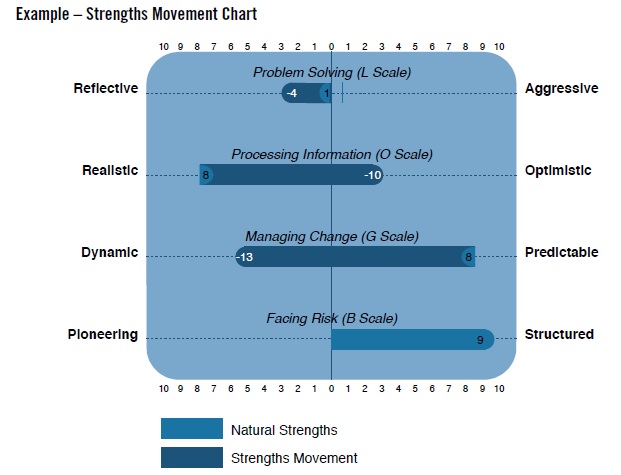Get the Most Out of Your Profile Data
Fourth in a series explaining how Certified Practitioners help you process profiles
After you complete a Leading From Your Strengths profile assessment, you receive a 20-page personalized profile report. Its length alone provides a considerable amount of useful information. You will gain some initial insight simply by reading the report on your own, but you will get the most out of the data when you review it with a certified practitioner.
The practitioner will take you through at least four steps to help you understand your strengths and use them in a healthy, productive way.
A Practitioner’s 4-Step Process to Helping You Understand Your Strengths
Step #1: Determine Your Dominant Strengths
The Strengths Chart, a key element of your report, presents a visual picture of the predictable ways you naturally solve problems, process information, manage change, and face risk. You have a unique combination of responses in those four situations. In the report, the four areas are presented as horizontal continuums, each with a scale of numeric strengths. The strengths have equal weight and are all equally important, no matter where they plot on the chart.
 The practitioner uses your Strengths Chart data, combined with special resources, to determine your dominant strengths. Your dominant strengths reveal how you are most likely to respond in typical situations and under pressure. The practitioner also helps provide you with descriptor words to use to describe yourself to others.
The practitioner uses your Strengths Chart data, combined with special resources, to determine your dominant strengths. Your dominant strengths reveal how you are most likely to respond in typical situations and under pressure. The practitioner also helps provide you with descriptor words to use to describe yourself to others.
In reading the report on your own, you are not likely to unpack this information.
Step #2: Identify Correlations Between Your Strengths
The Strengths Chart assigns a numeric score for each of your strengths. The number reveals the intensity with which you display that strength.
As the practitioner studies your profile data, he compares the numeric score in each of the four areas with the other three. The point spreads show strong, moderate, or weak correlations between different strengths.
Why is this information significant? Strong correlations give the most accurate descriptors of your strengths. They deserve the highest priority as you plan purposeful interactions. Moderate correlations are considered next, while weak correlations may not be accurate enough to give full consideration. Correlations show you where to invest yourself first in your activities and in your relationships.
Step #3: Pinpoint Key Emotions
As your practitioner explains your strengths in each of the four inescapable areas – and helps configure the intensity in how they correlate with each other – you will discover descriptors that portray how you respond in situations and relationships. Most users are surprised to discover the perceived accuracy of this data is at or above 90%
But it is at this point that your practitioner points you to even more helpful information, revealing how your strengths work to both demonstrate and protect your emotions. The practitioner helps you see how you naturally respond emotionally – and how you might respond emotionally when feeling threatened or pressured. This information is especially useful as you work on strategies to deal with stress or challenges in a useful, more productive way.
Step #4: Discover How You Adapt
While Strengths Chart shows your natural way of handling problem solving, processing information, managing change, and facing risk, the profile also provides a Strengths Movement Chart. This visual tool shows how you may feel you need to respond to be successful in your current environment. It is information that is extremely valuable in helping you understand how you adapt to your current situation, whether it is your job, team, group, or home life.
You can tolerate adaptation to your environment for short periods, but long-term the adaptation saps you of energy. The Strengths Movement Chart helps reveal areas where you are making accommodation.
When a practitioner studies both charts and discovers a strengths movement of 5 points or more in any of the four areas, he will help you to identify the source of stress … and then recommend purposeful interactions to allow that person to use his strengths more effectively.
Because it is impossible for two people to get the same exact results in from their Leading From Your Strengths profile, the information in the report is detailed, customized specifically for you … and extremely valuable.
A certified practitioner can help you get the most out of yours.
More Articles from The Practitioner Series
Ways a Certified Practitioner Can Help You, Part 1: Introduction
Ways a Certified Practitioner Can Help You, Part 2: Are You Independent or Interdependent?
Ways a Certified Practitioner Can Help You, Part 3: Four Ways You Are Unique
